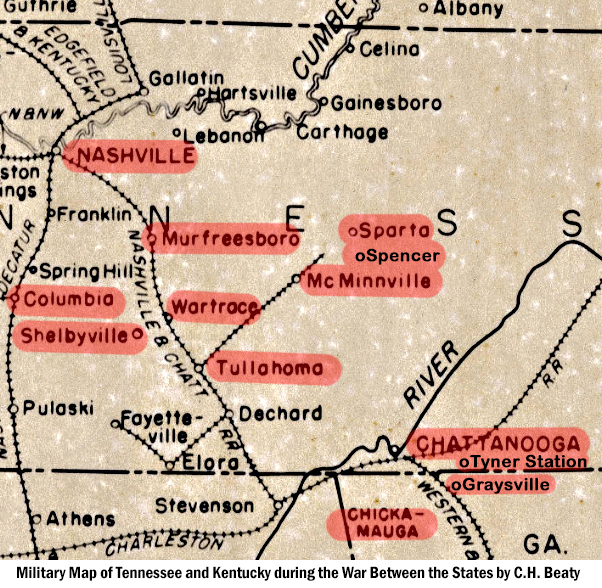The Mystery of the Civil War Yankee Officer's Sword


I wish there was more I could say about this sword, but pretty much all that is known in the Haston family is that at some point after the Civil War, a Federal officer’s story was found in a hollow tree on the farm where Confederate soldier, Montgomery G. Haston, lived during and shortly after the Civil War.

The sword has been kept in the family, but the stories of who found it, when it was found, specifically where on the farm it was found, and how it got there have been lost over time. However, I will offer one theory:
Perhaps M.G. Haston Took It Home as a Souvenir
Just a Theory, Not a Proven Fact
Montgomery Greenville (M.G.) Haston was a grandson of Daniel Haston, through an illegitimate birth by Polly Haston, daughter of David Haston. He became a prominent citizen and civic leader in Van Buren County, TN. On June 4, 1861, twenty-seven days before Tennessee was admitted to the Confederacy, M.G. was appointed to be Captain of the Home Guard for his district of Van Buren County. According to the following 1862, a Confederate camp (probably a training ground) was established on the M.G. Haston farm.

In April 1863, M.G. resigned his office of Justice of Peace for his 4th District, as well as his position as Tax Collector for Van Buren County. He joined Company C of the 35th Regiment of Tennessee’s Confederate Infantry, as a private, on June 16, 1863. Later that month, he was fighting in the strategic Tullahoma (TN) Campaign, only about 60 miles SW of his home.

In the spring of 1863, M.G. Haston and other citizens of surrounding counties knew they were facing the possibility of a Federal Army occupation. And they knew what occupation by enemy troops would mean. Pro-southern guerilla fighters–some of whom were nothing more than thieves, robbers, and murderers–were dangerous enough. But a massive occupation by Federal troops would be devastating to farms and their families.
The only thing preventing that occupation was the Army of Tennessee under the leadership of General Braxton Bragg. But Bragg’s army had fought to a draw in Murfreesboro’s Battle of Stone’s River and retreated to take a stand at Tullahoma. Bragg, and all of western Middle Tennessee, were facing the realities of (1) a win at Tullahoma and a forced retreat of the Union Army, or (2) a surrender of south-central Tennessee to a swarming army of enemy soldiers.
After a few days of positioning and fighting in miserable rain, General Bragg chose to retreat to Chattanooga. Much to the disappointment of many of his troops, especially those recruited from southcentral Tennessee, Bragg left businesses, farms, and families (especially pro-Southern families) wholly unprotected.
Immediately, many of the Confederate volunteers from that local area began to desert, to go home to protect their wives, children, and property. The defensive mode became personal to many of them, the dike had burst and the flood of enemy raiders was at hand.
M.G. Haston remained with Bragg and the Army of Tennessee in the retreat to “Tanner’s Station” (Tyner), east of Chattanooga. He reported for the July 17, 1863 muster there. But deserted on July 31.
If you study the life of M.G. Haston, you will know he was not a coward. He, no doubt, deserted because he knew the “dam had burst” at Tullahoma and his home area was now flooded with Federal soldiers. His farm, his wife, and his children, most of whom were very young, were vulnerable to abuse by swarms of Yankee soldiers, some/many of whom had no qualms about raiding, robbing, raping, and destroying–especially anything or anyone belonging to a Confederate soldier. And M.G.’s farm and family were no doubt high priority targets. And M.G.’s farm was sitting in a major crossroad that would have been heavily traversed by Yankee predators, as well as unscrupulous Rebel guerrillas.
So, perhaps M.G. took possession of the sword somewhere in his battle experiences and brought the sword home with him. If so, maybe he hid it in a hollow tree, knowing that if he had been discovered with it (during or even after the war) he would have been hanged or shot. He died a few years after the war (December 20, 1869). Maybe the hiding place of the sword was unknown to anyone else, thus it remained hidden for years following his death.
Other Possible Theories
Perhaps a Federal officer stuck his sword in the hollow tree and forgot it? Not likely. Perhaps someone other than M.G. Haston hid the sword in the tree and forgot it? Maybe, but it’s doubtful. Perhaps someone stole the sword from a Federal officer and hit it in the tree so the officer couldn’t find it? Again, not likely. Any other ideas – Leave a Reply (below).
More About Montgomery Greenville (M.G.) Haston
If you appreciated this article, please share it with others who might also enjoy it.


4 thoughts on “A Hidden Yankee Sword Found on a Confederate Haston Farm”
Perhaps a Yankee soldier deserted his post and came upon the farm finding unprotected women and children. He attacked one of the women but they fought back and killed the Yankee soldier burying him near the hollow tree and marking his grave site with the sword. (What happened on the farm stayed on the farm 😉) by Donna Hancock
Hmmm, interesting theory Donna. The family lore says that M.G.’s wife slept in front of the door with a shotgun across her lap.
Any record of when the sword was found in the hollow tree, ….or when and where it was made? It looks to be in very good shape..
I agree with Donna that where there is a hidden enemy sword, there was likely to be a buried body. In a family cemetery in my county, word has it that two Confederate soldiers were buried in unmarked graves near the gates and that cemetery is known to have unmarked graves long forgotten. In this part of Missouri there were many Confederate residents who might have sheltered wounded Confederate deserters from the Battle of Lexington 30 miles away. The area was teeming with bushwhackers and guerillas from both sides.